With the presence of a lawn comes the need to take care of it properly. One solution? Sprinkler system!
Sprinkler system takes a lot of work off your shoulder, but they’re not only good for your lawn, but they’re also bad for it. It is very important to know when to turn on sprinklers, how long they should run, and at what intervals. There is a significant relationship between the correct or standard sprinkler head run time and a healthy lawn. Here’s what you should know.

Recommended sprinkler run times?
First things first: testing
Before determining how long and how often you should water your lawn, first take into account how much water is actually flowing into your lawn when the sprinkler system is left on.
Sprinkler hours
The simplest test you can do is the tin can test.
This is a method that uses simple household items such as tuna cans or even tin utensils to measure the amount of water actually entering the ground.
Simply spread the containers over the lawn and leave the sprinkler system on for their normal or set operating time.
Make sure your containers are the same size to get an accurate idea of how much water your lawn is getting.
Once the sprinklers are running, take the cans and measure the amount of water inside each. It will also give you an idea of the most irrigated areas and the areas that are in the blind spot of the sprinkler system.
With this information, also keep in mind the length or depth of your grass roots. This gives you a rough estimate of how long it will take to build up enough water to reach the roots, which is the most important part of keeping the grass moist.

Planning
You can program most sprinkler systems to operate at specific times of the day for a selected period of time.
After running tests in the cans and calculating the time it takes the water from the sprinkler heads to reach the grass, also take into account the sun, where it rises and sets, and when the sun is at its peak.
Watering your lawn when the sun is at its strongest just leaves room for waste and water to evaporate. Watering session at night leaves the grass more room to rot overnight.
Planning your sprinkler system is the best way to approach this and is what I recommend.
How long should the lawn be watered?
There are many factors that go into determining how long you should water your lawn. These include the grass type, your climate, how often you water, how you water your lawn, and more.
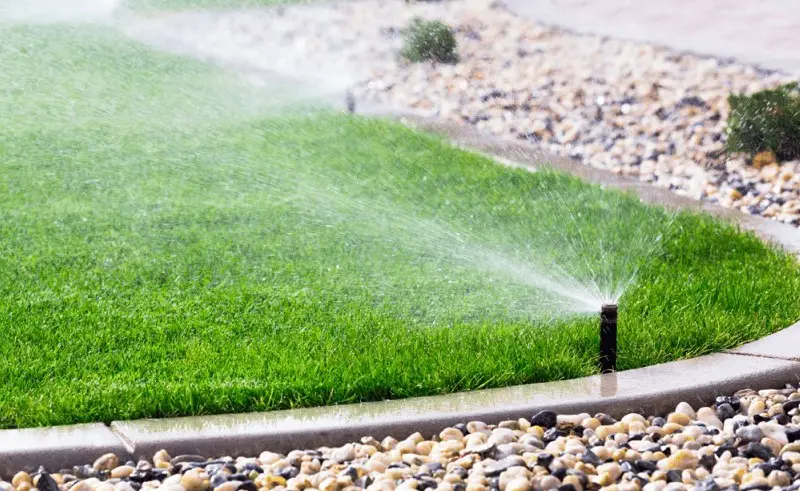
Understanding your lawn
Before discussing watering session and watering times, it’s first important to understand your lawn in terms of its roots, the grass you have, and how your location can affect this.
All of these factors are, after all, essential to successfully finding the perfect watering schedule and run time for your lawn.
Determine your lawn’s weekly watering needs.
First, find out how many inches of water your lawn needs per week. Most require an average of 1 to 1½ inches per week, but specific watering needs depend on the type of lawn (cool or warm season), the particular grass, and the time of year (active or inactive growing season).

Cool and warm seasonal herbs
Like any plant, some herbs grow best in cooler climates, and some can grow in warmer or hotter conditions. Choosing the right grass type for your climate can help you limit the need for lawn watering.
Cool season herbs
Cool season grasses grow best in climates between 65 and 75 degrees Fahrenheit.
Most used for lawns are cool season grass. Common cool season herbs are tall fescue and Buffalo grass.
These grasses thrive during cooler seasons and often remain dormant during hotter seasons.
Warm season herbs
Warm season grasses are the exact opposite of cool season grasses and thrive in warmer and hotter temperatures.
Augustine and Bermuda grass are common warm season grasses and require less water to care for than cool season grasses because these plants have already adapted to their environment.
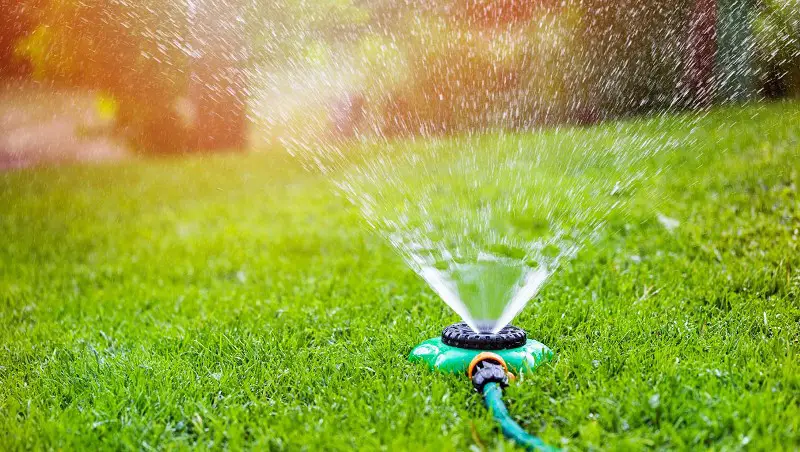
Watering the lawn (the right way)
In order to properly water your lawn and ensure the best results in terms of moisture, color, and overall lawn health, it is important to understand your irrigation system in terms of the different types of irrigation system, the different tests you can run, and productive watering to determine the best watering schedule for best results.
To save water (and money), water at the right time.
If the sprinkler heads are running in the middle of a summer day, most of the water the lawn craves evaporates before it hits the ground. This depends on the day and the dryness of the air, as well as the speed of the wind, which can carry the sprayed water away from the intended purpose of the lawn.
According to the Environmental Protection Agency (EPA), about half of the water used outdoors is wasted because it evaporates, is blown away by the wind, or pools, and runs off the lawn when applied too heavily.
Of course, evaporation is worse in dry climates (where water is the least!). In any community, the best time to water the grass is in the early morning, usually between 6 am and 10 am. Many cities have ordinances requiring residents to only water their grass in the early morning and evening.
With the onset of the evening, there is less evaporation, but the wind can be stronger than before dawn. In addition, a watered lawn that has been kept damp all night can lead to fungal lawn diseases.

What type of lawn spreader is best?
With the exception of a well-designed underground system, oscillating sprinkler systems are best suited. This type of sprinkler head evenly distributes water in a rectangular pattern. Overlap each area (including lawn edges) by at least 10%. Pivot sprinkler heads leave gaps in the irrigation system pattern. With circle patterns, you have to overlap each area by 50% to get even coverage.
The greatest stress from heat and drought occurs on hillsides, along the edges of sidewalks, streets, and driveways. However, these areas are often underwatered to avoid wasting water on the pavement.
Be extra careful and use more water in these areas if you can.
Are drop spreaders better than broadcast spreaders?
The broadcast spreader will ensure that different parts of the lawn receive even coverage. The drop spreader is more accurate because it doesn’t spread granules or seeds, and it doesn’t change the amount of material spread based on changes in walking pace.
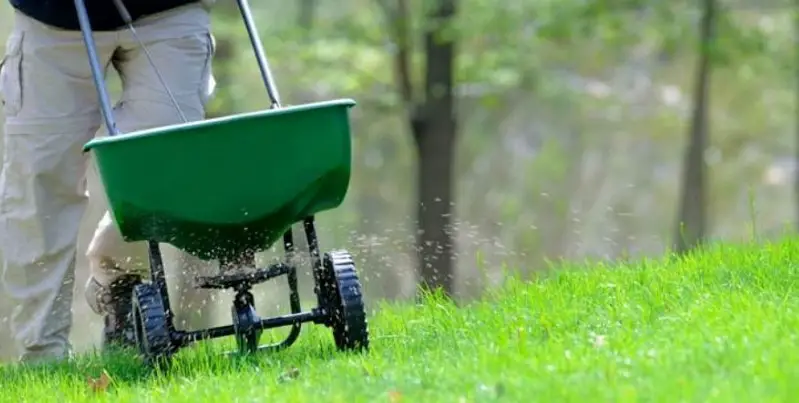
What is a drop spreader?
As the name suggests, the drop spreader is designed to use gravity and apply fertilizer, herbicides, or seeds directly below the spreader through the bottom holes. When the spreader vibrates, materials fall through a series of holes, evenly distributed.
Drop spreaders are either manual or towed. They allow you to set the flow rate according to the specific project, and this makes the adjustment very convenient for use in urban areas when it is necessary to avoid splashing material on neighboring flower or vegetable beds, and the neighbor’s lawn.
Advantages of the drop spreader
Very accurate due to the fact that the spreader is directly below.
Won’t waste material or scatter it on areas like a neighbor’s property, near your house, or worse, in your flower beds along the edge of the grass.
The scattering rate from the hopper bucket is easy to calibrate to control material flow.
drop Spreader Disadvantages
Easy to create lines in the yard. If you don’t waste an extra second before going down each line, making sure they overlap, it’s easy to create lines without material. These lines in your yard are created by small swathes that are not seeded or fertilized.
It will take more trips around the yard to cover the entire area.
They can spray water.

What is a broadcast distributor?
The broadcast spreader is either pushed by hand or can be towed behind a lawn mower or other small vehicle such as an ATV. As material falls from the large green hopper, it hits the flywheel. This flywheel plate has special grooves that rotate as the implement moves forward, causing the material to be spray heads in a wide arc, distributing seed, herbicide, or fertilizer evenly.
They are effective at covering a very large area at the same time as they diffuse materials from the bottom, front, and sides.
Benefits of a Broadcast Distributor
Capable of spreading very quickly, covering a much larger surface area at once. You don’t have to focus on walking in straight lines and crossing your path back and forth. You can quickly move around the yard, and being close enough to your path, you will be able to apply the material evenly.
Because of the large coverage areas, this is ideal for open areas where placement accuracy is not as important.
Saves time. Being able to quickly cover areas reduces the time it takes to do so, as well as the number of round trips you would have to make on foot when using the manual version.
They can spray water.
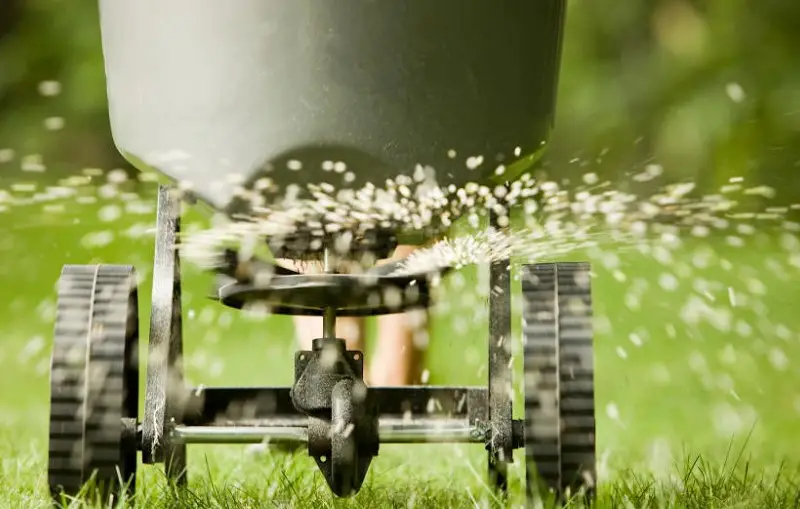
When is a broadcast distributor better?
The broadband spreader is great when you need to cover a large area of lawn with the product and don’t have to worry about the accidental application to sensitive areas.
Most homeowners don’t want to spend hours tending their lawn, and a broadcast spreader is a huge time saver and helps you get the most coverage in the least amount of time. It can help you stay on track with a complete lawn care regimen: pre-emergence herbicides in early spring, nitrogen and summer growth fertilizers, and fall seeds.
When is the best time to use a drop spreader?
Small yards are best served with a drop spreader. Smaller lawns make it easier to stay on the path when walking back and forth, and because of the need to overlap your paths, it won’t be as much of a burden compared to using it on a huge grass turf.
It is highly recommended to use a drop spreader around sensitive areas rather than a widespread spreader because you don’t want to throw grass seeds into flowers or vegetable gardens, or worse, have herbicide sandy soil in those areas.
The simple fact that a drop spreader allows you to be very precise in your job is the main reason lawn professionals will always have both tools.
Using a widespread spreader for the middle and most of the yard and then running around the edges with a drop spreader is how most professionals will apply the material in an urban setting, getting the best of both worlds for their job sites.
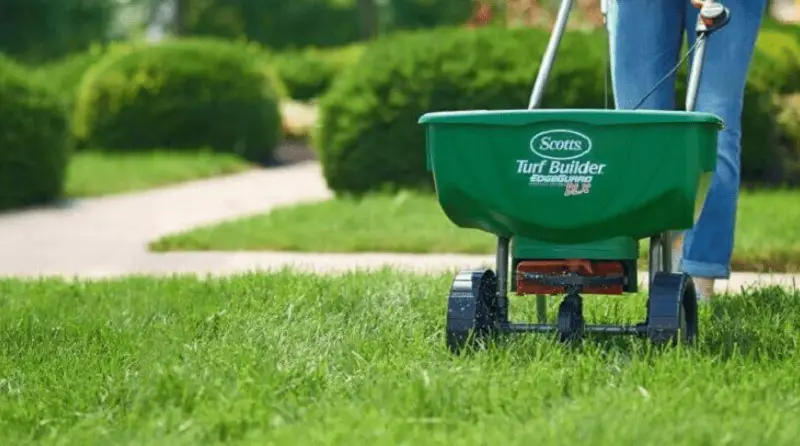
What type of fertilizer spreader is best?
Before choosing a specific spreader, consider the various specifications and the yard or area you want to use the spreader on. How much property will the spreader need to cover?
Do you want to push the spreader by hand or pull it behind a lawn mower or other vehicle? Do you need a fully assembled one? Consider the following highly rated spreaders to help you make the right choice.
Working method
The most popular spreaders are broadcast because they offer a balance between speed and accuracy. Manufacturers produce these spreaders in a variety of sizes, from small hand-held models to very large spreaders that can be pulled behind vehicles.
Drop spreaders are the best choice when users need to overcome obstacles and bottlenecks. They work exceptionally well in small to medium-sized yards with intensive landscaping.
Holding capacity
It is important to know the capacity of the spreader because this will determine how often the spreader will need to be refilled depending on the size of the area it needs to cover. Ideally, users will want to simply fill the spreader once and apply the product to the entire area.
Lawn capacity and lawn size go hand in hand. The hand spreader is well suited for small lawns up to 1500 sq ft.
For medium-sized lawns up to 5,000 sq ft, a small hand-operated spreader will do. Large manual spreaders are well suited for yards up to 20,000 sq ft. Buy a tow spreader if your yard is over half an acre.
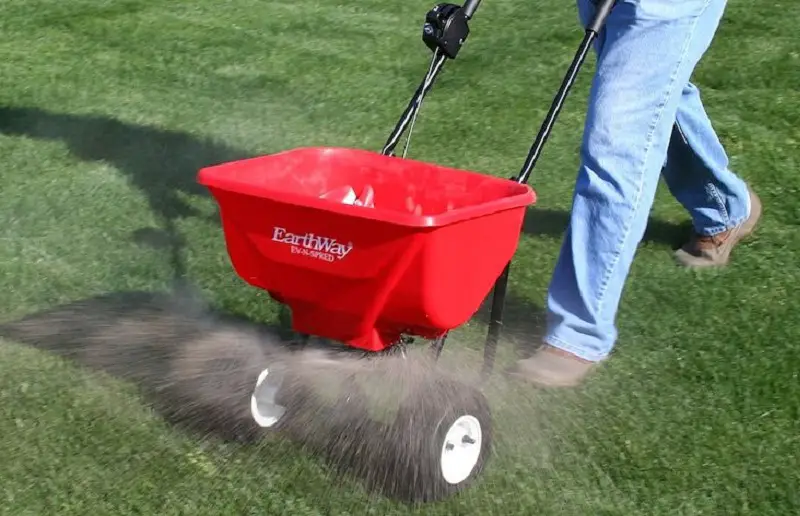
Spreading power
The spreading capacity refers to the types of material that the spreader can handle. All fertilizer spreaders are capable of spreading grass seeds and granular chemicals, but far fewer can handle sand, powdered lime, and compost.
Accuracy
All lawn spreaders provide better accuracy than manually spreading fertilizer. However, some spreaders are more accurate than their competitors. Precision and speed are opposed to each other in the case of spreaders. Drop spreaders are accurate but slower. Broadcast spreaders are slightly less accurate, but faster. Liquid dispensers are not precise, but fast enough.
Drop spreaders are the most accurate because manufacturers calibrate them for a constant flow rate to spread only a thin sliver directly below the hopper, located between the wheels.
You can calibrate the broadcast spreader to provide a constant flow rate, but you must walk at a constant pace for even coverage. Manufacturers calibrate liquid spreaders to accurately mix the amount of concentrate per gallon of water, but you control the flow rate.
What drop spreader is good for? Drop spreaders are best suited for smaller lawns or areas requiring a precise application.
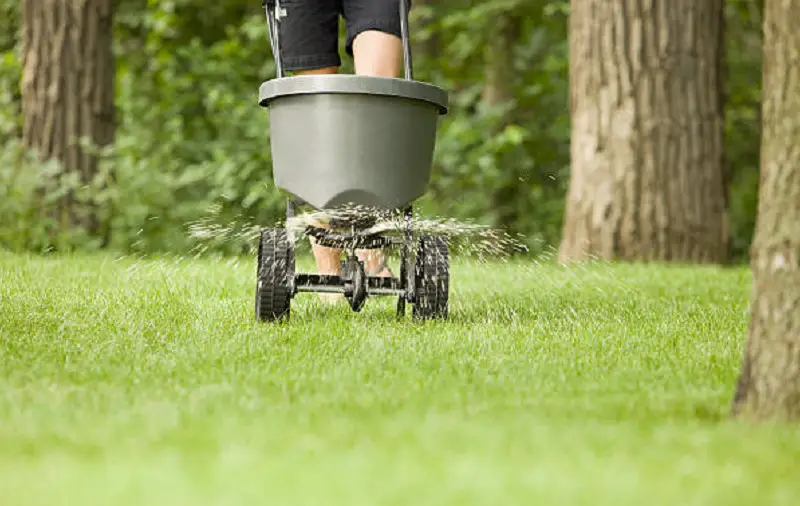
Conclusion
Your lawn is just as important as the interior of your home. It reflects how you take care of your interior and sends a message to everyone who passes by your home. Mowing the lawn is not enough; ensuring that your lawns are healthy and lush through proper care is vital.
- Why Are There Still No Tomatoes in My Tomato Plants? Let’s Fix the Issue! - July 13, 2023
- Water Propagation White Stuff on Roots: Everything You Should Know! - July 11, 2023
- String of Dolphins Drying Up: Solved! - July 11, 2023
